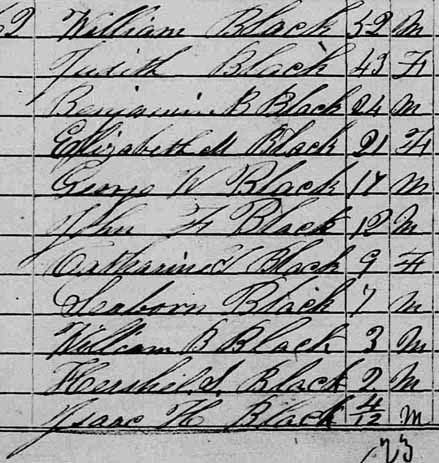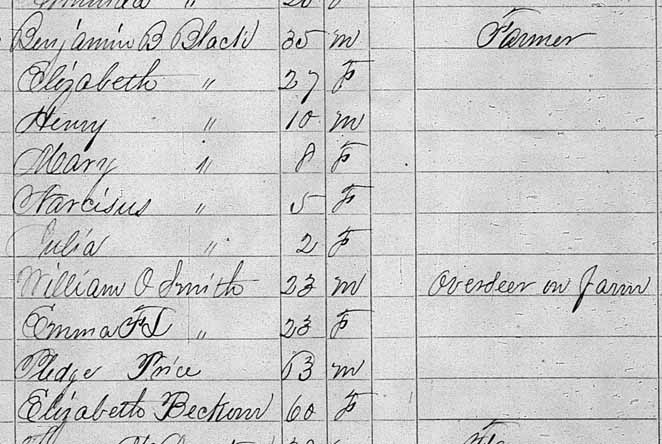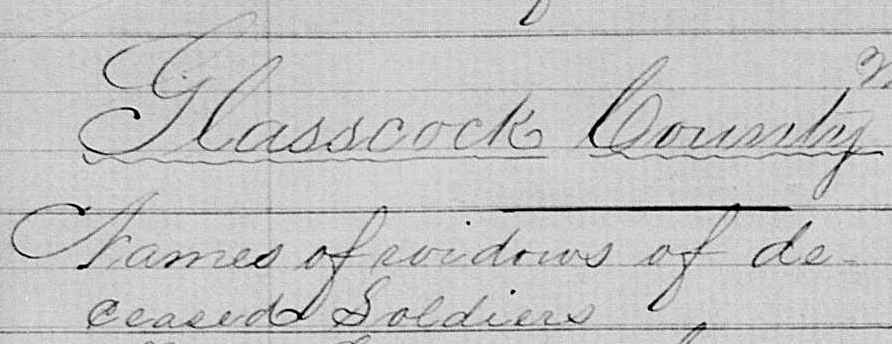- map
- how you can help
- FAQ's
- contact
- copyright
-
ahnentafel and citation # display:| |

| Snapshot: | farmer; Confederate soldier and POW |
| Parents: | 180William Black 181Juda Thompson |
| Born: | 17 July 1826 Jefferson County, Georgia |
| Last known record: | 7 January 1905 Johnson County, Georgia |
| Buried: | unproven; see below |

The 1830, 1840, and 1850 censuses all show (or imply) that

Somewhat strangely, two months later the newlyweds still lived in


The American Civil War began the following year. Strangely,
| • | The name "Benj. B Black" is on a muster roll dated 14 September 1861 for the Jackson Guards, |



| • | On 11 July 1862 |
Early in the war, draftees could avoid serving by hiring someone else to take their place. Unfortunately, after receiving payment many substitutes would desert as soon as practical, while others were barely physically fit enough to fight in the first place. Not surprisingly, then, Confederate substitutes had a generally bad reputation. Like many other substitutes,
| 29-30 August 1862: Second Manassas (a.k.a. Second Bull Run) — in Wright's Brigade, R. H. Anderson's Division, under Longstreet | |
| 17 September 1862: Sharpsburg/Antietam — in Wright's Brigade, Anderson's Division, under Longstreet | |
| 11-15 December 1862: Fredericksburg — in Wright's Brigade, Anderson's Division, under Longstreet | |
| 30 April 1863: Chancellorsville — in Wright's Brigade, Anderson's Division, under Lee |
By 30 June 1863,
His desertion didn't last long. On 6 August 1863 he was arrested in Winchester, Virginia by the 8th Virginia Cavalry,

He left Camp Chase on 29 February 1864, was transferred to Fort Delaware, and arrived there on 4 March. Fort Delaware was another, even worse Union-run POW camp. Fellow inmate Reverend Isaac W. K. Handy described the conditions:
It has not been uncommon here for our half-clothed, half-fed Confederates at the barracks to be ordered about in the coarsest and roughest manner by their inferiors, and to be knocked on the head with sticks, or to be stuck with bayonets, for the slightest offences; and, sometimes (for no crime whatever), men have been shot at or cruelly murdered by sentinels, who bore malice, and justified themselves upon the plea that they were trying to prevent escapes. Sick men have been kept at the barracks until perfectly emaciated from diarrhea, without the necessary sick vessels, and have been obliged to stagger, through the quarters, to the out-house on the bank of the river, with filth streaming upon their legs; and then, unable to help themselves, they have fallen upon the pathway, and have been found dead in the morning—victims of cruel neglect. Barefooted, bareheaded and ragged men, tottering with disease, have been left to suffer long for the necessary clothing or medicines, which might have been abundantly supplied [...]
15

A salt ration list from late 1864 suggests that


In a December 1864 roll,

In 1867 the U.S. Congress passed several Reconstruction Acts. These Acts divided the former Confederacy into several military occupation zones, which were ruled by Union military commanders. The Acts also directed the commanding officers to register Southerners who wanted to vote in upcoming elections. One registration requirement was to swear an oath of loyalty to the United States; the obvious intent was to disfranchise any lingering Confederate resistance.

By 1870 he was back in Washington County, Georgia.

By 1874 he'd moved to Glascock County,

By 1887 he was in Johnson County,




By 1898 he had taken up work as a basket-maker.
He signed a document on 7 January 1905, and that is the last record I have found of him.
A book by the Johnson County Historical Society claims that
1: Georgia Confederate pension office, RG 58-1-1. Application for B. B. Black, page 2. Georgia Archives Virtual Vault record ID USAMILCONFEDGA_182689-00461, <https://vault.georgiaarchives.org/digital/collection/TestApps/id/93149/rec/4545>, accessed 27 January 2020. Hereafter abbreviated as "Pension application."
2: 1850 U.S. Federal Census (Population Schedule). Warren County, Georgia. Page 130B, dwelling 62, family 62, William Black household. NARA microfilm publication M432, roll 86. FamilySearch, <https://www.familysearch.org/ark:/61903/3:1:S3HT-XCML-2N?cc=1401638&personaUrl=%2Fark%3A%2F61903%2F1%3A1%3AMZY6-7VC>.
3: Compiled Confederate service record of Private Benjamin B. Black of Company A, 48th Georgia Infantry, page 11. NARA microfilm publication M266, roll 489. National Archives Catalog, <https://catalog.archives.gov/id/78875216> et seq., accessed 23 February 2020. Hereafter abbreviated as "Service record."
4: 1830 U.S. Federal Census. Warren County, Georgia. Page 229, Wm Black household. NARA microfilm publication M19, roll 21. FamilySearch, <https://www.familysearch.org/ark:/61903/3:1:33SQ-GYY1-FC1?cc=1803958&personaUrl=%2Fark%3A%2F61903%2F1%3A1%3AXHGB-LFJ >.
5: 1840 U.S. Federal Census. Warren County, Georgia. Page 22, line 51, William Black household. NARA microfilm publication M704, roll 53. FamilySearch, <https://www.familysearch.org/ark:/61903/3:1:33S7-9YTB-9SY2?i=2&cc=1786457&personaUrl=%2Fark%3A%2F61903%2F1%3A1%3AXHBN-YFK>
6: Warren County, Georgia. Marriage book for the years 1848-1873, page 50, marriage of Benjamin Black and Elizabeth Sutton. FamilySearch, <https://www.familysearch.org/ark:/61903/3:1:33S7-9BZ3-ZLB?cc=1927197&personaUrl=%2Fark%3A%2F61903%2F1%3A1%3AKXJK-6C7>, accessed 27 January 2020.
7: 1860 U.S. Federal Census (Population Schedule). Washington County, Georgia. Page 203, dwelling 334, family 326, Benjamin B Black household. NARA microfilm publication M653, roll 140. FamilySearch, <https://www.familysearch.org/ark:/61903/3:1:33SQ-GYBT-8KT?cc=1473181&personaUrl=%2Fark%3A%2F61903%2F1%3A1%3AMZM4-P1W>.
8: Muster roll dated 14 September 1861 for the Jackson Guards, Washington County, Georgia. Ancestry.com ("Georgia, U.S., Civil War Muster Rolls, 1860-1864" / Washington / images 20 and 21 or 54), accessed 8 May 2023.
9: Service record, op. cit., page 2.
10: Lillian Henderson, Roster of the Confederate Soldiers of Georgia, 1861-1865, volume 5 (Longina and Porter, Hapeville, Georgia 1959), page 103.
11: Service record, op. cit., page 6.
12: ibid., page 7.
13: ibid., page 12.
14: Judson McCranie. "Camp Chase, Columbus, OH, US (08).jpg." Photograph. Wikimedia, <https://commons.wikimedia.org/wiki/File:Camp_Chase,_Columbus,_OH,_US_(08).jpg>, accessed 28 January 2020.
15: Isaac W. K. Handy, United States Bonds; or Duress by Federal Authority: A Journal of Current Events During an Imprisonment of Fifteen Months, at Fort Delaware (Turnbull Brothers, Baltimore, 1874) pages 201-202.
16: Wikimedia user Brahmslover. "Inside of reconstructed Prisoner Barracks, Fort Delaware.jpg." Photograph. Wikimedia, <https://commons.wikimedia.org/wiki/File:Inside_of_reconstructed_Prisoner_Barracks,_Fort_Delaware.jpg>.
17: Georgia. Adjutant and Inspector General's Office (Commissary General's Department). Military records 1862-1864, pages 654, column 2, entry for Mrs. B. B. Black. FamilySearch, <https://www.familysearch.org/ark:/61903/3:1:3Q9M-CS73-KBM7?cat=487301&i=337&lang=en>, accessed 2 May 2025.
18: Service record, op. cit., page 16.
19: Statutes at Large, Treaties, and Proclamations of the United States of America, volume 13 (Boston, 1866), page 738.
20: Georgia's 1867-1868 Voter Registration Oath Books. Volume 125 (Hancock County Book A), page 97, entry 193, Benjamin B. Black. Ancestry.com ("Georgia, Returns of Qualified Voters and Reconstruction Oath Books, 1867-1869"). Although I copied the image from Ancestry.com, the corresponding microfilm at the Georgia Archives is microfilm 296/45.
21: 1870 U.S. Federal Census (Population Schedule). Militia district 96, Washington County, Georgia. Page 23, dwelling 191, family 187, Burt W. Black household. NARA microfilm publication M593, roll 182. FamilySearch, <https://www.familysearch.org/ark:/61903/3:1:S3HT-DTBS-4YM?i=22&cc=1438024&personaUrl=%2Fark%3A%2F61903%2F1%3A1%3AMCQ9-CYW >.
22: 1870 U.S. Federal Census (Agriculture Schedule). N. B. Giles' district, Washington County, Georgia. Pages 41-42, entry 29, Burt N. Black farm. NARA microfilm publication T1137, roll 8. FamilySearch, <https://www.familysearch.org/ark:/61903/3:1:3QHV-R3L2-6WKW?cat=589484&i=843>. The NARA provides a helpful template.
23: Glascock County, Georgia. Tax digest for 1874, section for militia district 1168, entry for Benjamin B. Black. FamilySearch, <https://www.familysearch.org/ark:/61903/3:1:3QHV-D3C4-Z9FY-G?i=370&cc=4130006&cat=260083>.
24: Glascock County, Georgia. Tax digest for 1875, section for militia district 1234, entry for Benjamin B. Black. FamilySearch, <https://www.familysearch.org/ark:/61903/3:1:3QHV-D3C4-Z9N1-F?i=410&cc=4130006&cat=260083>.
25: Glascock County, Georgia. Tax digest for 1876, section for militia district 1168, entry for Benjamin B. Black. FamilySearch, <https://www.familysearch.org/ark:/61903/3:1:3QHV-D3C4-Z9J8-L?i=427&cc=4130006&cat=260083>.
26: Glascock County, Georgia. Tax digest for 1877, section for militia district 1168, entry for Benjamin B. Black. FamilySearch, <https://www.familysearch.org/ark:/61903/3:1:3QHV-D3C4-Z9VZ-F?i=458&cc=4130006&cat=260083>.
27: Glascock County, Georgia. Tax digest for 1878, section for militia district 1168, entry for Benjamin B. Black. FamilySearch, <https://www.familysearch.org/ark:/61903/3:1:3QHV-D3C4-Z9N4-8?i=488&cc=4130006&cat=260083>.
28: Glascock County, Georgia. Tax digest for 1879, section for militia district 1168, entry for Benjamin B. Black. FamilySearch, <https://www.familysearch.org/ark:/61903/3:1:3QHV-83C4-Z9X7-6?i=522&cc=4130006&cat=260083>.
29: Glascock County, Georgia. Tax digest for 1880, section for militia district 1234, entry for Benjamin B. Black. FamilySearch, <https://www.familysearch.org/ark:/61903/3:1:3QHV-83C4-Z96Q-9?i=569&cc=4130006&cat=260083>.
30: Glascock County, Georgia. Tax digest for 1881, section for militia district 1167, entry for Benjamin B. Black. Ancestry.com ("Georgia, U.S., Property Tax Digests, 1793-1892" / Glascock / 1881-1887 / images 14 and 15 of 594), accessed 20 May 2024.
31: Glascock County, Georgia. Tax digest for 1882, section for militia district 1169, entry for Benjamin B. Black. Ancestry.com ("Georgia, U.S., Property Tax Digests, 1793-1892" / Glascock / 1881-1887 / images 120 and 121 of 594), accessed 20 May 2024.
32: Glascock County, Georgia. Tax digest for 1884, section for militia district 1167, entry for Benjamin B. Black. Ancestry.com ("Georgia, U.S., Property Tax Digests, 1793-1892" / Glascock / 1881-1887 / images 266 and 267 of 594), accessed 20 May 2024.
33: Glascock County, Georgia. Tax digest for 1886, section for militia district 1167, entry for Benjamin B. Black. Ancestry.com ("Georgia, U.S., Property Tax Digests, 1793-1892" / Glascock / 1881-1887 / images 432 and 433 of 594), accessed 20 May 2024.
34: 1880 U.S. Federal Census (Population Schedule). Militia district 1234, Glascock County, Georgia. Enumeration district 32, page 29, dwelling 261, family 261, Berton Black household. NARA microfilm publication T9, roll 148. FamilySearch, <https://www.familysearch.org/ark:/61903/3:1:33SQ-GYYT-99NZ?i=6&cc=1417683&personaUrl=%2Fark%3A%2F61903%2F1%3A1%3AM8GM-1T9 >.
35: Johnson County, Georgia. Tax digest for 1887, section for militia district 1201/Wrightsville, entry for Burton B. Black. Ancestry.com ("Georgia, U.S., Property Tax Digests, 1793-1892" / Johnson / 1882-1887 / images 664 and 665 of 812), accessed 26 February 2025.
36: Johnson County, Georgia. Tax digest for 1890, militia district 1201, pages 2 and 3, B. B. Black. Ancestry.com (“Georgia Property Tax Digests, 1793-1892” / Johnson / 1890 / images 3 and 4 of 130), accessed 24 October 2021.
37: 1900 U.S. Federal Census (Population Schedule). Johnson County, Georgia. Enumeration district 53, sheets 41B and 42A, dwelling 752, family 776, Burton B Black household. NARA microfilm publication T623, roll 207. FamilySearch, <https://www.familysearch.org/ark:/61903/3:1:S3HY-D1K9-F1K?i=81&cc=1325221&personaUrl=%2Fark%3A%2F61903%2F1%3A1%3AM3J8-FMP>.
38: Pension application, op. cit., page 3.
39: ibid., page 5.
40: ibid., page 11.
41: Johnson County Historical Society, Searching for Our Ancestors Among the Gravestones: A Cemetery Record of Johnson County, Georgia, 2nd edition (Johnson County Historical Society, 2000), pages 212-213.